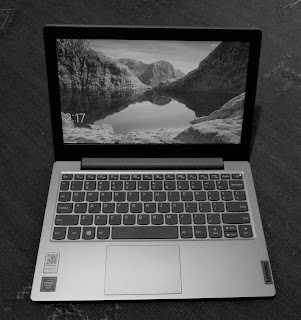Almost every year, round about this time, I've done a blog post on my personal use of information technology over the past twelve months.
This year past has seemed at times like Groundhog Day with repeated lockdowns, but the good news was that the project to document the contents of Dow's Pharmacy restarted in April. Lockdowns and even an earthquake caused some delays meaning that I've probably managed only half the amount of work I would normally have managed, but it's certainly way better than 2020 when we shut down at the end of March for what turned out to be a twelve month hiatus.
The methodology and equipment remain the same, more or less. The methodology works well and the only major, but very successful innovation was the use of a wheelie box to move my gear.
At home there's been rather more in the way of changes - my seven year old chromebook finally died on me, and at the same time I bid farewell to my old 32bit linux netbooks. In fact, I seem to have lost the need for linux in my life - obviously I need a project to revive my interest.
My Huawei mediapad continues to function well, it's amazing how useful having a second device on which to look things up while working on something is, While most of my work is on my Lenovo laptop I'm still giving deskspace to my 2008 vintage iMac, purely because of its large screen when looking at scans of old documents.
Also still getting deskspace is my old Thinkpad Yoga I bought second hand, It was originally supposed to replace my MacBook Air, but in practice turned out to be just that little bit too heavy to carry around.
However it has a valuable role as a second machine, and once I set up a little work area in the corner of the old garage - which is also destined to become Judi's art studio - it will probably move in there.
The MacBook Air continues to soldier on, but has finally been replaced as a travel computer by one of these eMMC based lightweight computers, which has proved more of a success than I expected - light, responsive, good battery life. It's obviously a lighter built machine than the Air and will probably have shorter working life, but even so I'm amazed at how good a sub $300 machine is.
The Air itself, even though it is out of operating updates continues to work well and run a recent version of chrome. It did have a bit of a glitch earlier this year when sometimes it wouldn't charge. I bought a third party power supply which seemed, for a month or three to solve the problem until it developed the dreaded blinking green light. This could suggest something serious or just a dud charger, The cheapest solution was to buy a refurbished charger to see if it solved the problem, which so far, it seems to have.
The old iPad mini I bought a year or two ago and tricked out with a keyboard finally came into its own as a note taker, but the real tablet success was the dogfood tablet, using a cheap, in fact the cheapest seven inch Android tablet I could find as an ereader for Gutenberg epubs, and digitised books from Google Books, plus pdf's of research papers - simple, lightweight, and with good battery life it's proved genuinely useful.
However, the real star of 2021 is the Lenovo Smart Clock Essential that I bought more or less on a whim.
I had a whole lot of Telstra plus points that I'd accumulated over the years that I'd never used, and Telstra were offering the basic smart clock to Telstra plus members for not a lot of points. Cynically, I suspected they were trying on unload old stock, but we needed a new bedside clock in the bedroom, so I reckoned that even if we never used the voice activated features it would tell the time well enough.
I'm personally a little bit suspicious of voice activated assistants ever since I saw a non-disclosure presentation of one of the early assistants back in the nineties - picky on accent and pronunciation, and prone to give downright weird responses, but I've got to say I'm impressed at how well the assistant copes with my Australian by way of Edinburgh accent as well as Judi's posh end of Melbourne with a bit of London accent. The only glitch is that it seems to have decided that we live in Wooragee (a 100m or so lower) rather than Beechworth.
Sound reproduction from the speaker is pretty good - ABC Jazz sounds as good as it does on our internet radio, and of course it can access your Spotify account and playlists.
Basically, it's pretty good. In fact, I'm so impressed by it I've just bough a second one for Judi's studio to use as clock cum smart speaker so she can play music while painting without covering usb sticks and cd's with paint and pastel dust ...





